W3: Colour Perception
1/36
There's no tags or description
Looks like no tags are added yet.
Name | Mastery | Learn | Test | Matching | Spaced |
|---|
No study sessions yet.
37 Terms
THE DRESS: Why do people see it in different colours?
Over-exposure of the image.
Different viewing angles/screens affecting color perception.
Varying color terminology used among individuals.
Color blindness.
Individual differences in individual color processing
Individual differences in individual experiences.
Failures in color constancy leading to discrepancies in perception.
(1) The image is overexposed
Over-exposure makes colors in the photograph differ from the actual dress.
However, people varied in how they saw the colours in the PHOTOGRAPGH not between the pic + irl
SO = over-exposure = not the only cause
(2) Different viewing conditions
Evident variations in perceived colors due to:
Changes in image size
Changes in viewing angle
Laboratory findings (Sousa, Hermann and Conway, 2015):
53% of individuals perceive the dress as blue-black
40% as white-gold
SO = not just viewing conditions
(3) Problems naming colours
Different names used for perceived colors.
It was a forced-choice question
‘is this white and gold or blue and black?’
Forced-choice questions can lead to variances in responses.
Investigating colour naming
Naïve observers tend to provide similar answers in open-ended questions = forced-answer q is not the issue
Distinctions appear when asked to match colors; groups favor different matches.
SO = Naming discrepancies do NOT fully explain color perception differences.
Visible Spectrum
Overview of light wavelengths and how they correspond to different types of light, including:
Cosmic rays, X-rays, ultraviolet, infrared, and visible spectrum.
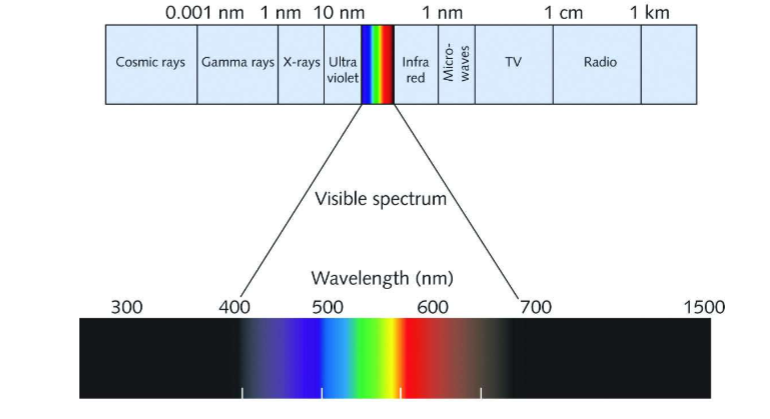
Where is colour processed?
Color processed across various areas:
Retina ➔ LGN ➔ V1 ➔ V4/V8
Dorsal stream = ‘Where / Action’
involved in motion detection
3D shape recognition
actions (events, sequences)
emotions
Ventral stream = ‘What / Perception’
involved in form perception
object identification
facial recognition
colour
Photoreceptor types: Rods and Cones
Rods: Responsible for night vision, monochromatic (one colour only)
Cones: Three types (S, M, L) for color vision + daylight
Blue = S-type
Green = M-type
Red = L-type (daylight vision only)
Sensitivity analysis of cones across different wavelengths (blue, green, red).
Colour Vision and the Visible Spectrum
Visible spectrum = the part of the spectrum that human eyes are sensitive to
Most mammals = only 2 cone types
Humans, apes, monkeys = 3 cone types
Many other animals = multiple (>3)
Snakes = can see infra-red (we don’t bc we’re warm blooded)
Birds + Insects = can see ultra-violet (we don’t bc it damages retina over long periods so we screen most of it out - birds don’t live as long as us)
Summary of Photoreceptors
3 types of cone photoreceptor for daylight vision
Each type responds to a range of colours = but most strongly to one wavelength (colour)
With 1 cone type = can see a range of colours BUT cannot discriminate between them
With 2 tuned to blue + yellow = can discriminate blues from yellows BUT not green-yellow-orange-red
With 3 = can discriminate all colours in the visible spectrum
We only have one type of rod photoreceptor for night vision = we are colour blind at night
With 1 cone type we can…
see a wide range of colours but cannot discriminate between them
With 2 cone types tuned to blue + yellow we can…
discriminate blues from yellows but not green-yellow-orange-red
With 3 cone types we can…
discriminate between all the colours in the visible spectrum
Colour blindness
most ‘colour blind’ people can see colour - just not properly
some have mis-tuned cone type = they can’t discriminate certain colours well
some have a missing cone type = dichromats
common colour-blindness = mis-tuned green cone
red-green cone colour genes carried on X chromosome = red-green colour blindness is more common in men than women
some women have 4 cone types = tetrachromats
monochromats = 1 cone type (rare)
v rare = rod monochromats = no cones = truly colour blind + cannot see in daylight
Common colour deficiencies
Protanopia = no red
Protanomaly = miss-tuned red
Deuteranopia = no green
Deuteranomaly = miss-tuned green
Tritanopia = no blue

True colour blindness
Cone monochromates = only 1 cone type
Rod monochromats = no cones at all (cannot see in daylight)
= both very rare
Cerebral achromatopsia
= cortical colour blindness
following a stroke / injury = patient cannot see colour at all
photoreceptors, retina, LGN, V1 = all intact
stroke affects V8 region of visual cortex
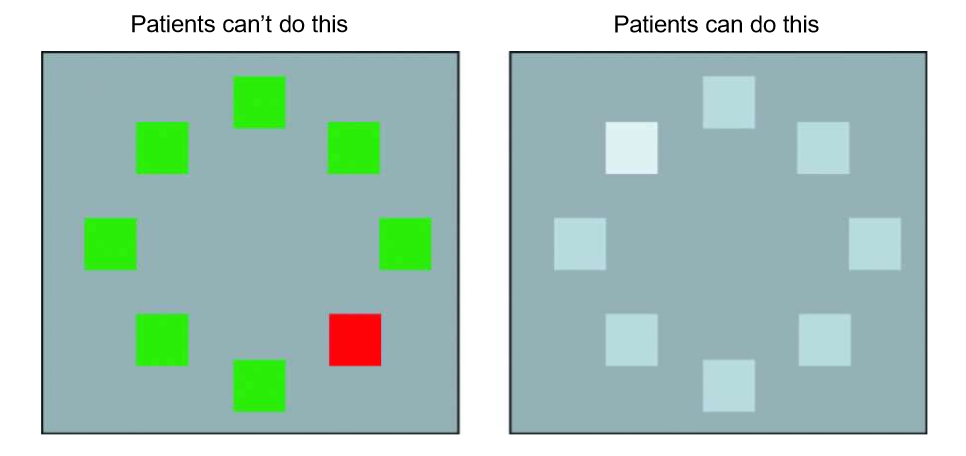
(4) Colour blindness and the dress
the number of people who are colour blind is much LOWER than the people who saw the dress as an ‘odd’ colour
the colours in the photograph = blue + yellow/brown
the number of people with blue cone colour blindness = v low (<0.01% of population)
SO, colour blindness CANNOT explain the dress illusion
How colours are processed in human vision = colour opponency
2 colour systems:
Ancient luminance + yellow/blue system (common in most mammals)
Newer red/green systems = genetic adaptation of the yellow part of the older system
Colour opponency
One member of the color pair suppresses the other color.
We do see yellowish-greens and reddish-yellows, but we never see reddish-green or yellowish-blue color hues.
Opponent Colors: Our vision system doesn’t just detect individual colors—it compares them.
There are two main opponent color pairs:
Red vs. Green
Blue vs. Yellow
This means that when one color in a pair is active, the other is suppressed. For example, if you see red, green is reduced.
Colour opponency image
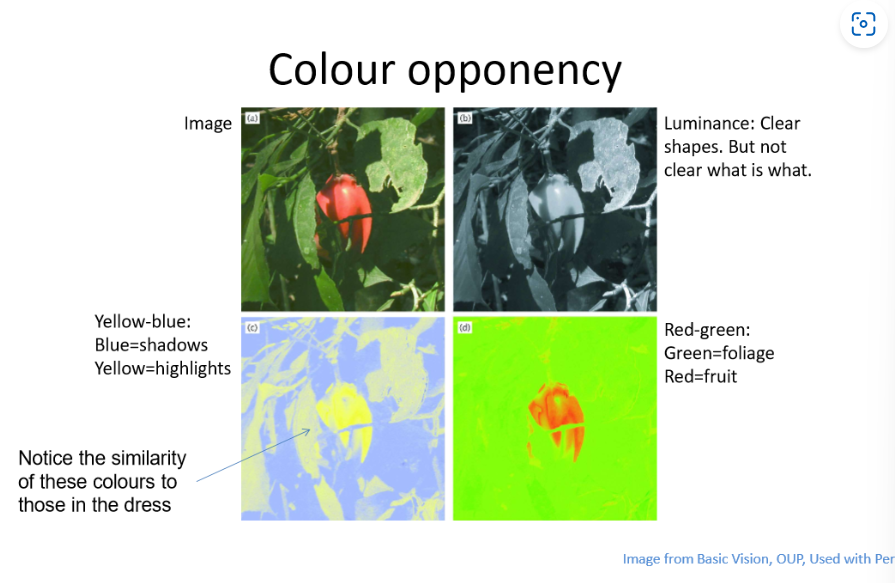
Colour opponency in retina and LGN
the Red-Green, Blue-Yellow appearance is misleading
Red-Green is closer to what we would call reddish and greenish orange
Yellow-Blue is closer to lime-violet
the centre-surround properties of retinal ganglion cells = provides the mechanism for colour opponency
these cells calculate the ratio of colours and provide edge detection mechanism
(5) Individual differences in colour processing and the dress
blue + brown dots are measured colours from the dress image
most of the variation is on the blue-yellow system
the red dots show peoples setting for neutral grey/white
SO - what people see as neutral varies between the colours in the dress image
SO - individual variations in the blue-yellow system could explain people’s perception of the dress
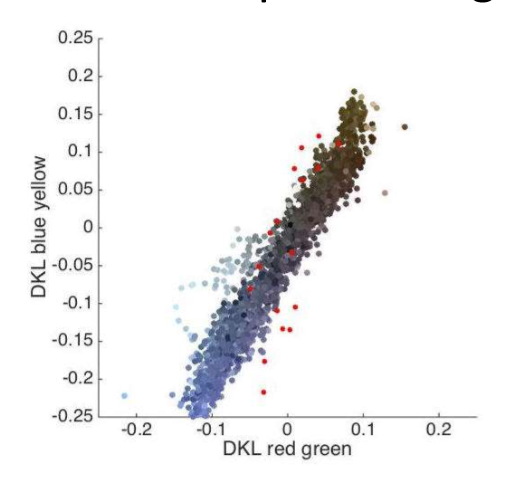
Inhibition over space + centre-surround + simultaneous colour contrast
perhaps the spatial context in which you view the dress can change its colours
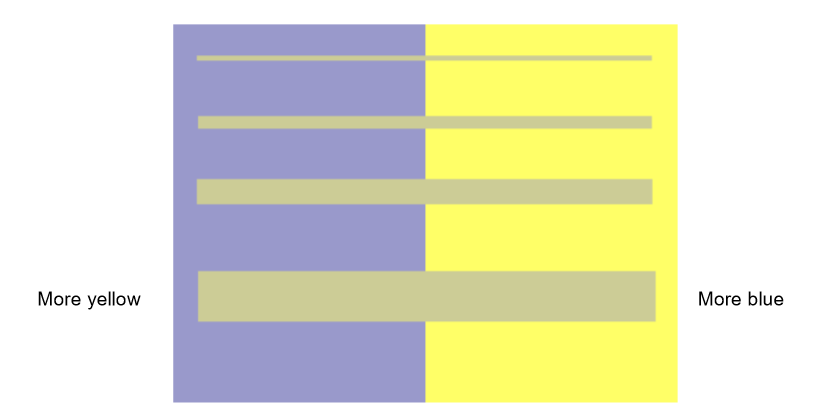
Inhibition over time: colour after-effects
perhaps the lighting conditions over time in which you view the dress can change its colours
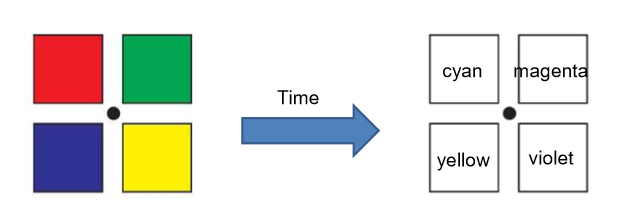
Excitation in cortex - colour filling in
colour centre-surround cells in the retina only transmit the colour edges = the cortex must reconstruct the body colour of the object
water colour illusion: these images show only the edges outlined in colour
they pass through the retina to the cortex
cortex automatically fills in the gaps with a sense of colour
SO - maybe the stripes in the dress could facilitate filling in + alter the perception of the dress
(6) individual differences - experience and the dress
things that alter colour perception
simultaneous colour contrast
colour after-effects
water colour illusion (filling in)
simultaneous colour contrast + filling in might explain any effects = due to surrounding colours
colour after-effect might explain = short term changes over-time
surrounding + ambient colours do change over time (e.g. daylight vs indoor)
SO - these effects suggest variability over time (but within observers)
SO - not enough to explain the data collected under lab conditions
Colour constancy
the colour of light reflected from objects depends on:
their colour
and the colour of the light that shines on them
we don’t notice objects changing colour when ambient light changes (dawn-dusk)
to do this = we ‘ignore’ the light source
we do not know how this is done
where = occurs in V8 (sub-section of area V4)
colour constancy = the ability to perceive colors of objects, invariant to the color of the light source
called white balance correction (on a camera)
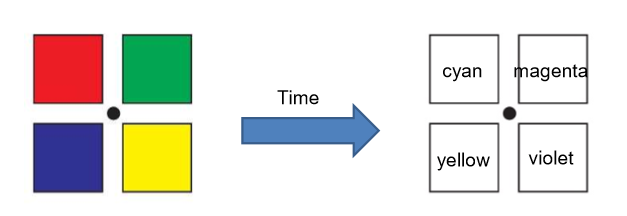
Cortical areas V1, V2, V4 + V8
colour sensitive cells in V1 + V2 cluster into regions of cortex that are separate from the rest of the cells
Colour signals are then passed to a sub-section of V4 = called V8
V8 = responsible for the conscious perception of colour
Area V4/V8 + Colour Constancy
V1 vs. V4/V8 Areas in the Brain:
V1 (Primary Visual Cortex) = processes basic color information but does not adjust for changes in ambient light.
V4/V8 (Higher Visual Areas) = help correct for lighting changes, making colors appear more stable.
Colour perception:
V1 response to white patch when ambient light its green = response changes bc V1 does NOT discount ambient light
V4 response to white patch when light is green = stays the same bc V4 DOES discount ambient light

(7) Colour constancy and the dress
In dress image = no context to tell actual colour of ambient light
SO - subconsciously pick either yellowish or blueish light
light source colour you pick = determines perception of dress
people who saw white-gold = assumed it was daylight = brain ignored bluer wavelengths
people who saw blue-black = assumes warm, artificial light = brain ignored redder wavelengths
this likely depends on the yellow-blue system = which is tuned to highlights and shadows
SO - individual differences in the yellow-blue system may promote one precept over the other
contrast effects and after-effects may produce additional biases over time = causing some people to change their precept
Key points about colour vision
We get colour vision by having 3 cone photoreceptor types
rods = only support night vision (we are all colour blind at night)
most colour-blind people just have one missing or mis-tuned cone type
cerebral achromatopsia / cortical colour blindness = results from a loss of area V8
suggests this area is responsible for conscious colour perception
the colour system is arranged like spatial vision with:
centre-surround cells in the retina - centre-surround prefer diff colours
filling in (probs in area V1)
SO - we get simultaneous colour contrast + colour after effects + water colour illusion
colour constancy = our ability to ignore the colour of the light source (in area V4/V8)
Protanopia
no red cone
Protanomaly
mis-tuned red cone
Deuteranopia
no green cone
deuteranomaly
mis-tuned green cone
tritanopia
no blue cone